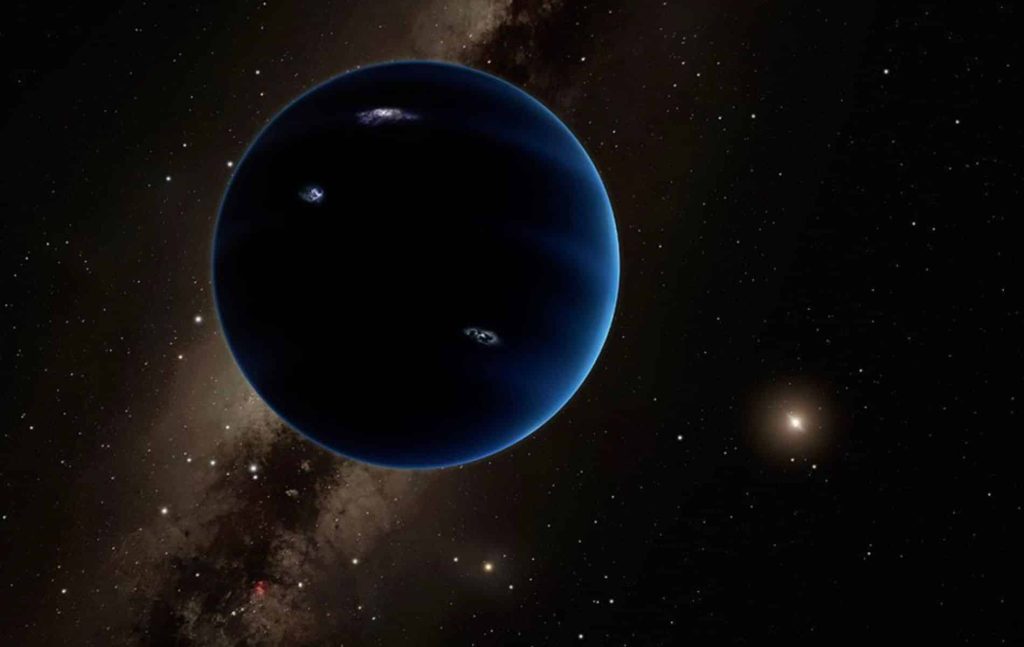The solar system has 8 planets. But in 2016, two American researchers conclusively confirmed that there are 9 secret ones: In the outer regions of our solar system – far beyond the orbit of Neptune – there is said to be an as-yet-undiscovered planet that is five times heavier than Neptune. the earth. It has now been almost 8 years and this “Planet 9” has not yet been discovered. Here the question arises: Does it exist or not?
In January 2016, it made world news: astronomers Konstantin Batygin and Mike Brown announced that they had found strong evidence that our solar system has not eight planets, but nine. They base their conclusions not on direct observations of that planet, but on the fascinating motion of six Kuiper Belt objects: a massive group of comet-like objects outside the orbit of Neptune. All the objects in question have elliptical orbits, but they follow the same direction in physical space. As a result, they all approach perihelion (the point in their orbit at which they are closest to the Sun) at about the same angle and arrive at about the same place (see also the image below). The so-called “orbital element clustering” of these objects in the Kuiper Belt cannot be a mere coincidence. “The chance that this is just a coincidence is only 0.007%,” Brown said in 2016. “There has to be something driving the path of these objects.” That is: the ninth planet.
Doubts
Professor Simon Portiges Zwart, an astronomer at Leiden University's Leiden Observatory, says he still remembers his first reaction to the news, Scientias.nl. “I had my doubts.” These doubts initially have their origins in the language used by Brown and Batygin. “In their research article and accompanying press release, they talked about 'evidence' of a Planet Nine. This is bold language for a scientist. There was no evidence at all; there was only an indication – in the form of the clustering of the orbital elements of a handful of asteroids – that it was possible.” That there is a ninth planet.
Follow up research
It has now been nearly eight years and Portiges Zwart still has his doubts about the existence of Planet 9. The big difference is that these doubts are no longer based on just a simple annoyance about the use of language, but are also supported by scientific research. “Planet 9 is a very innovative solution to a strange problem: the rather strange orbits of some objects in the Kuiper Belt,” says Portiges-Zwart. “But if I sit down and think about it, I can find three, four, or even six explanations for this 'problem'.” His fellow astronomers have already done this in recent years. And indeed: in recent years, several studies have been published in which scientists have shown that the movements The apparently strange Kuiper belt objects can be easily explained even in the absence of Planet Nine.” For example, there are studies suggesting that the gravitational influence of the Oort cloud (a hypothetical cloud filled with comet-like objects surrounding the solar system, ed.) could also explain the strange orbits of the objects. Kuiper belt.”
Selective search?
This makes Planet Nine in 2023 – at best – just one of the possible explanations for the problem. Portiges Zwart confirms that the problem has not yet been proven. Because a cluster may have been discovered in the orbital elements of asteroids, but does this cluster exist? Or do we just think so? “Kuiper Belt objects are located 600 astronomical units from the Sun, or 600 times the distance between the Earth and the Sun,” Portegis Zwart explains. “That's very far. In addition, these objects are dark, very small, and move quickly. These are four reasons why these objects are difficult to observe. Our best chances of spotting them occur when an object like this – thanks to its very elliptical orbit – comes relatively close to the Sun.” Many have been discovered. Objects in the Kuiper Belt at a time when their orbit brought them closer to the Sun. What would happen if researchers found a Kuiper Belt object in such a place? Then they say: “Hey, you can discover beautiful things there, let's take a look there again.” And they soon find another one. “If you look this way, everything looks close to the sun,” says Portiges-Zwart. But the reality is different, of course; We discover most Kuiper Belt objects relatively close to the Sun, because that's actually the only place we can see them well. And here they are clues The clustering of orbital elements that Batygin and Brown are trying to explain with their Planet 9 is also the result of such selective research. Because some of these orbital elements — including an elliptical orbit and the fact that objects come relatively close to the Sun — are what make them ideal for discovery. If astronomers then see one of these Kuiper Belt objects approaching perihelion from a certain direction, they tend to look for more in the same direction, Portiges-Zwart says. “In this case, the researchers only observed Kuiper belt objects in a certain direction, because that is simply the direction in which they looked.” This means that the grouping of orbital elements is just an illusion; The result of a selective search, attention has simply not been paid to the countless Kuiper Belt objects that are hidden from our eyes, partly due to their misaligned – unconsolidated – orbital elements.
At loose ends
So there are indications that the problem that Batygin and Brown are trying to solve with their planet 9 does not exist. If we assume that the problem already exists, there are other solutions to that problem without the need to involve a ninth planet. In short: The Planet Nine hypothesis has never been strong, and it has been seriously undermined in recent years.
Actively searching
But this did not prevent Brown and Batygin from actively searching for the planet. “A lot of observation time and millions of euros have been invested in finding the planet,” says Portiges-Zwart. without result. But researchers do not hesitate about this. They continue to insist that the hypothetical planet – because it is not very large and located at a great distance from Earth – is difficult to observe. “That's their excuse: It's like looking for a needle in a haystack.” And of course this is true. “But I also think that research is a waste of observation time,” explains Portiges-Zwart. “Then I think: Let's use the telescope's time for other purposes and use it in a few years Vera C. Rubin Observatory Continue searching. Of course we will have to wait a little longer, but then we will know immediately what will happen.
Vera C. Rubin
He. She Vera C. Rubin Observatory – Currently under construction in Chile – it is specially designed to observe a large part of the sky and should, among other things, map small objects in the solar system – including Kuiper belt objects. “With this observatory, we will soon be able to determine whether there really is a problem or if it only appears to be so because of our selective way of observing, and thus we have been greatly wasting each other's time. It is also the perfect tool for discovering the planet. And to finally end this whole discussion.” As we mentioned, some patience is necessary, as the observatory is expected to open its doors in 2025.
By thread
So the fate of Planet 9 hangs in the balance for at least a few more years. But suppose now that within a few years we have to conclude that the planet does not exist. Should we then conclude that Brown and Batygin's hypothesis has really given us nothing? Because in response to the Planet Nine theory, many theorists have begun to test and further investigate this theory. “We worked hard,” stresses Portijes Zwart. “Brown and Batygin challenged intellectuals with an exciting problem, and then those intellectuals came up with creative solutions. This book has produced some wonderful theoretical work that I, as a scholar, have read with great pleasure. But wouldn’t this work have been done without the theory of Planet Nine? I don’t believe it; These creative people are definitely creative and this whole theory has gone nowhere for us.
It's a very sobering result almost eight years after the birth of the Planet Nine hypothesis. What the future – contains the beautiful Vera C. Rubin Observatory – It will take us further, as we continue to look at ground coffee. But recent studies that have seriously contributed to the figurative legs of the hypothetical Planet 9 have already tempered expectations considerably. If the observatory cannot detect a trace of Planet 9 within a few years, it will not come as a huge surprise or disappointment. Moreover, the observatory will likely make very different exciting discoveries in the Kuiper Belt at around the same time. “The Kuiper Belt is the deep sea of local astronomy: we don't understand a word of it,” says Portegis Zwart. “And that's a shame, because what exists and what happens there is close to the origin of the solar system, and therefore also to the origin of ourselves. There in the Kuiper Belt lies the answer to the question of how it got here: how Uranus and Neptune formed, how the planets migrated, etc. Ultimately, we just have to go out there and drill a hole in one of those Kuiper Belt objects to determine how the solar system and we eventually came into being. These are the big questions about life, where the question of whether Planet 9 exists or not is clearly diminished. No. “For me, the whole story about this Planet Nine and the search for it is too much about vanity and not enough about the scientific content. Of course, a planet has scientific value if it turns out to exist, for example for our understanding of the origins of the solar system. But if it doesn't “The planet exists, no one would really care about it.”

“Lifelong entrepreneur. Total writer. Internet ninja. Analyst. Friendly music enthusiast.”










More Stories
Linda Wagon Makers looks at her ‘amazing’ Eurovision Song Contest dress | RTL Street
Travel less thanks to the videophone in 1973 – RadioVisie
Counting down to Apple’s first event of the year, here’s what to expect